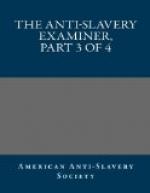“A lady, now in the West Indies, was sent in her infancy, to her friends, near Belfast, in Ireland, for education. She remained under their charge from five to fifteen years of age, and grew up every thing which her friends could wish. At fifteen, she returned to the West Indies—was married—and after some years paid her friends near Belfast, a second visit. Towards white people, she was the same elegant, and interesting woman as before; apparently full of every virtuous and tender feeling; but towards the colored people she was like a tigress. If Wilberforce’s name was mentioned, she would say, ’Oh, I wish we had the wretch in the West Indies, I would be one of the first to help to tear his heart out!’—and then she would tell of the manner in which the West Indian ladies used to treat their slaves. ‘I have often,’ she said, ’when my women have displeased me, snatched their baby from their bosom, and running with it to a well, have tied my shawl round its shoulders and pretended to be drowning it: oh, it was so funny to hear the mother’s screams!’—and then she laughed almost convulsively at the recollection.”
Mr. JOHN M. NELSON, a native of Virginia, whose testimony is on a preceding page, furnishes a striking illustration of the principle in his own case. He says:
“When I was quite a child, I recollect it grieved me very much to see one tied up to be whipped, and I used to intercede with tears in their behalf, and mingle my cries with theirs, and feel almost willing to take part of the punishment. Yet such is the hardening nature of such scenes, that from this kind of commiseration for the suffering slave, I became so blunted that I could not only witness their stripes with composure, but myself inflict them, and that without remorse. When I was perhaps fourteen or fifteen years of age, I undertook to correct a young fellow named Ned, for some supposed offence, I think it was leaving a bridle out of its proper place; he being larger and stronger than myself took hold of my arms and held me, in order to prevent my striking him; this I considered the height of insolence, and cried for help, when my father and mother both came running to my rescue. My father stripped and tied him, and took him into the orchard, where switches were plenty, and directed me to whip him; when one switch wore out he supplied me with others. After I had whipped him a while, he fell on his knees to implore forgiveness, and I kicked him in the face; my father said, ’don’t kick him but whip him,’ this I did until his back was literally covered with welts.”
W.C. GILDERSLEEVE, Esq., a native of Georgia, now elder of the Presbyterian church, Wilkes-barre, Penn. after describing the flogging of a slave, in which his hands were tied together, and the slave hoisted by a rope, so that his feet could not touch the ground; in which condition one hundred lashes were inflicted, says:
“I stood by and witnessed the whole without feeling the least compassion; so hardening is the influence of slavery that it very much destroys feeling for the slave.”




